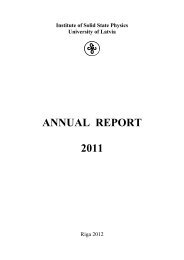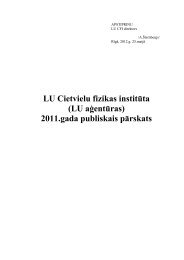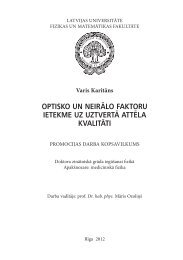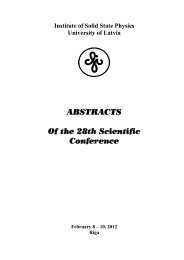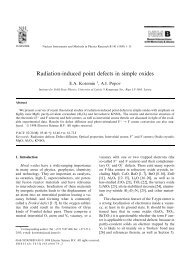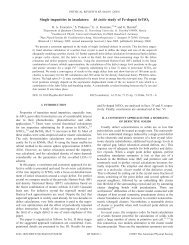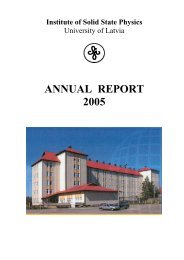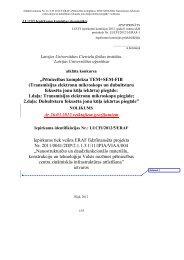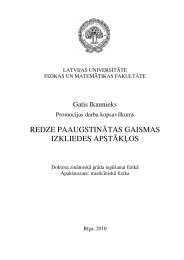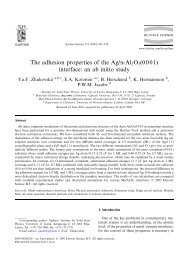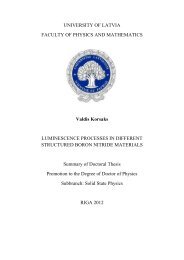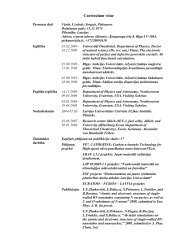Annual Report 2012 - Latvijas Universitātes Cietvielu fizikas institūts
Annual Report 2012 - Latvijas Universitātes Cietvielu fizikas institūts
Annual Report 2012 - Latvijas Universitātes Cietvielu fizikas institūts
Create successful ePaper yourself
Turn your PDF publications into a flip-book with our unique Google optimized e-Paper software.
Drain<br />
CNT<br />
Source<br />
Drain<br />
GNR<br />
Source<br />
50 nm<br />
Charges<br />
a<br />
Force<br />
Preasure forces<br />
50 nm<br />
b<br />
Gas molecules<br />
50 nm<br />
c<br />
Antibodies<br />
Antigens<br />
50 nm<br />
d<br />
Fig.12. FET-type nanodevices as prospective nanosensor systems: a) the unperturbed<br />
field-effect transistors based on CNT and GNR are presented (CNT- or GNR- based<br />
FETs are mainly composed of the corresponding semiconducting carbon materials<br />
suspended over the two electrodes); b) physical nanosensors: a conducting threshold can<br />
be altered when the nanotube or graphene ribbon is bent; c) chemical nanosensors: this<br />
threshold can be altered when the amount of free charges on the nanotube of graphene<br />
ribbon surface is increased or decreased depending on the presence of donor or acceptor<br />
molecules of specific gases or composites; d) biological nanosensors: monitoring of<br />
biomolecular processes such as antibody/antigen interactions, DNA interactions,<br />
enzymatic interactions or cellular communication processes, etc.<br />
Potential nanosensor devices based on CNTs and GNRs as well as their interconnects<br />
with various metallic electrodes are possible to design and to use for effective detection<br />
of external influences of different nature. They can change the electron transport regime<br />
and promote the current losses. At the same time, the interconnect interfaces can also be<br />
sensitive to chemical adsorbents, electrical and magnetic fields, changing the properties<br />
of interconnect potential barrier and the efficiency of conducting channels. Both these<br />
nanosensoring mechanisms can be simulated in the framework of the proposed models.<br />
AB INITIO MODELLING OF OXYGEN INTERACTION WITH<br />
SURFACES AND INTERFACES OF URANIUM MONONITRIDE<br />
D. Bocharov, D. Gryaznov, Yu.F Zhukovskii, E.A. Kotomin<br />
In collaboration with Institute for Transuranium Elements, Karlsruhe, Germany and<br />
Faculty of Computing, University of Latvia, oxygen adsorption, migration, incorporation<br />
into the surface N vacancies on (001) and (110) surfaces as well as oxygen behaviour<br />
between UN grain boundaries have been modeled (Figs. 13 and 14) using 2D slabs of<br />
different thicknesses and supercell sizes and the GGA exchange-correlation functional<br />
PW91 as implemented in VASP code. The Gibbs free energies of N vacancy formation<br />
65



